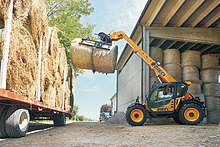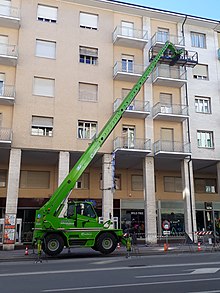
A skid loader, skid-steer loader, SSL, or skidsteer is any of a class of compact heavy equipment with lift arms that can attach to a wide variety of buckets and other labor-saving tools or attachments.

A forklift is a powered industrial truck used to lift and move materials over short distances. The forklift was developed in the early 20th century by various companies, including Clark, which made transmissions, and Yale & Towne Manufacturing, which made hoists. Since World War II, the use and development of the forklift truck have greatly expanded worldwide. Forklifts have become an indispensable piece of equipment in manufacturing and warehousing. In 2013, the top 20 manufacturers worldwide posted sales of $30.4 billion, with 944,405 machines sold.

Excavators are heavy construction equipment primarily consisting of a boom, dipper, bucket and cab on a rotating platform known as the "house" - although the largest form ever, the dragline excavator, eliminated the dipper in favor of a line and winch.

A crane is a machine used to move materials both vertically and horizontally, utilizing a system of a boom, hoist, wire ropes or chains, and sheaves for lifting and relocating heavy objects within the swing of its boom. The device uses one or more simple machines, such as the lever and pulley, to create mechanical advantage to do its work. Cranes are commonly employed in transportation for the loading and unloading of freight, in construction for the movement of materials, and in manufacturing for the assembling of heavy equipment.

A loader is a heavy equipment machine used in construction to move or load materials such as soil, rock, sand, demolition debris, etc. into or onto another type of machinery.

A backhoe—also called rear actor or back actor—is a type of excavating equipment, or digger, consisting of a digging bucket on the end of a two-part articulated arm. It is typically mounted on the back of a tractor or front loader, the latter forming a "backhoe loader". The section of the arm closest to the vehicle is known as the boom, while the section that carries the bucket is known as the dipper, both terms derived from steam shovels. The boom, which is the long piece of the backhoe arm attached to the tractor through a pivot called the king-post, is located closest to the cab. It allows the arm to pivot left and right, typically through a range of 180 to 200 degrees, and also enables lifting and lowering movements.
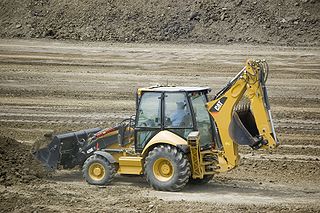
A backhoe loader, also called a loader backhoe, loader excavator, tractor excavator, digger or colloquially shortened to backhoe within the industry, is a heavy equipment vehicle that consists of a tractor-like unit fitted with a loader-style shovel/bucket on the front and a backhoe on the back. Due to its (relatively) small size and versatility, backhoe loaders are very common in urban engineering and small construction projects as well as developing countries. This type of machine is similar to and derived from what is now known as a TLB (Tractor-Loader-Backhoe), which is to say, an agricultural tractor fitted with a front loader and rear backhoe attachment.

Heavy equipment, heavy machinery, earthmovers, construction vehicles, or construction equipment, refers to heavy-duty vehicles specially designed to execute construction tasks, most frequently involving earthwork operations or other large construction tasks. Heavy equipment usually comprises five equipment systems: the implement, traction, structure, power train, and control/information.

An aerial work platform (AWP), also known as an aerial device, elevating work platform (EWP), aerial lift, cherry picker, bucket truck or mobile elevating work platform (MEWP) is a mechanical device used to provide temporary access for people or equipment to inaccessible areas, usually at height. There are distinct types of mechanized access platforms and the individual types may also be known as a "cherry picker", "boom lift" or "scissor lift".

A hydraulic cylinder is a mechanical actuator that is used to give a unidirectional force through a unidirectional stroke. It has many applications, notably in construction equipment, manufacturing machinery, elevators, and civil engineering. A hydraulic cylinder is a hydraulic actuator that provides linear motion when hydraulic energy is converted into mechanical movement. It can be likened to a muscle in that, when the hydraulic system of a machine is activated, the cylinder is responsible for providing the motion.

A compact or mini excavator is a tracked or wheeled vehicle with an approximate operating weight from 0.7 to 8.5 tonnes. It generally includes a standard backfill blade and features independent boom swing.
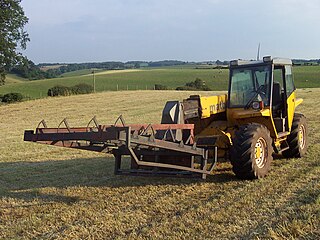
Matbro was a brand of lifting equipment, popular with farmers. Matbro produced a wide range of all terrain forklifts and telescopic handlers in their distinctive yellow livery, using engines derived from Ford and Perkins. Matbro began operating at a loss in the late 1990s and in the end went under in 2003 after accounting issues in their parent company Powerscreen. The old designs were then sold to the tractor company John Deere, which sub-licensed them to heavy lifting company Terex, who continued to evolve the designs, with new ideas such as side-mounted engines instead of rear ones and hydrostatic drive.

Material handling equipment (MHE) is mechanical equipment used for the movement, storage, control, and protection of materials, goods and products throughout the process of manufacturing, distribution, consumption, and disposal. The different types of equipment can be classified into four major categories: transport equipment, positioning equipment, unit load formation equipment, and storage equipment.

A reach stacker is a vehicle used for handling intermodal cargo containers in small terminals or medium-sized ports. Reach stackers can transport a container short distances very quickly and pile them in various rows depending on their access.

JLG Industries, Inc., a subsidiary of Oshkosh Corporation, is an American designer, manufacturer, and marketer of access equipment, including aerial work platforms and telehandlers. The company's products are utilized in various industries such as construction, fit-outs, industrial maintenance, material handling, and facilities maintenance. JLG was founded in 1969 and operated independently until its acquisition by Oshkosh Corporation in 2006. With a global presence, JLG is headquartered in McConnellsburg, Pennsylvania, United States. The company celebrated its 50th anniversary in 2019.
CVS Ferrari dates back to the 1940's, when it was previously known as THE FERRARI BELOTTI S.p.A. Belotti was the first company to design and build mobile handling equipment specifically for ports from their manufacturing facility on "Ponte Canepa" wharf.
A bucket is a specialized container attached to a machine, as compared to a bucket adapted for manual use by a human being. It is a bulk material handling component.
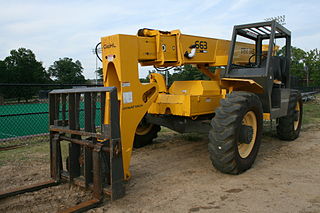
Gehl Company is an American manufacturer of compact equipment headquartered in West Bend, Wisconsin. The main campus in West Bend, built on 37 acres (15 ha), includes not only the headquarters but also the research and development facilities for the entire enterprise.
A Drum handler is a piece of mechanical equipment that is used to securely grip, lift and transport cylindrical modules such as steel drums, barrels, plastic drums and fiber drums. It has spring-loaded metal arms to create a tight and secure grip. This equipment is commonly used in chemical and petroleum industries, as well as industries that require shipping and storing of cylindrical modules.
Merlo S.p.A. is an Italian manufacturer of telescopic handlers based in Cuneo, Piedmont, with a 330,000-square-metre (3,600,000 sq ft) factory. It has over 600 dealers world-wide.




